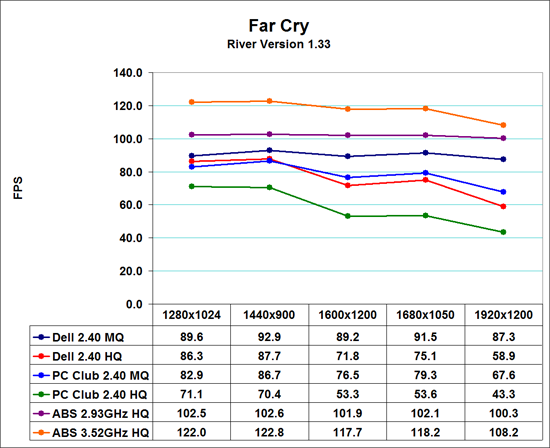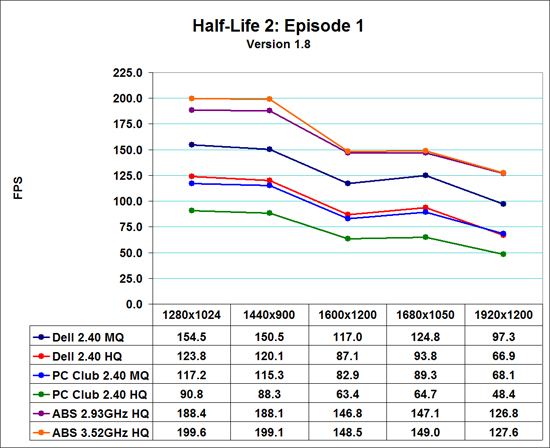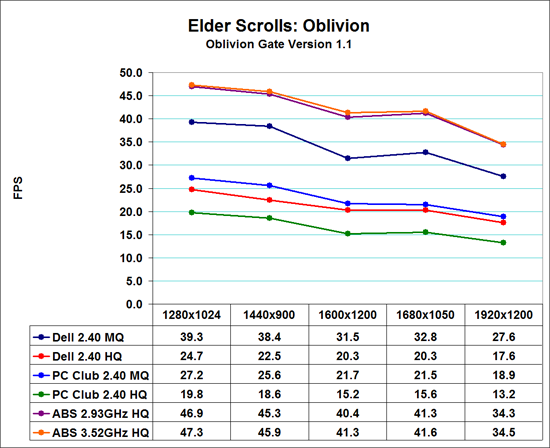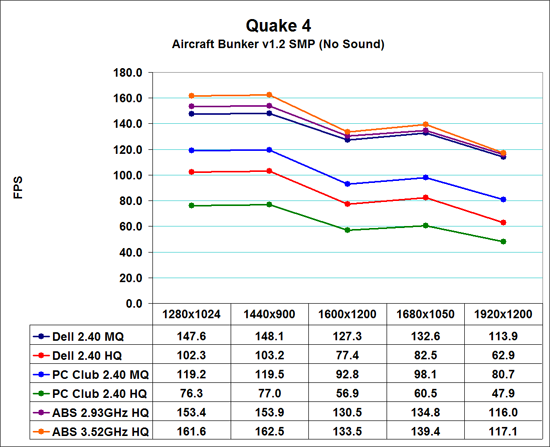Dell XPS 410: Core 2 Duo for the Masses
by Jarred Walton on September 18, 2006 12:20 PM EST- Posted in
- Systems
Gaming Resolution Scaling
As this is a system review, we will look at the gaming performance that can be achieved using the XPS 410 at lower resolutions and/or detail settings. We tested the five most commonly used resolutions for modern LCD displays at "high" and "medium" settings. We have provided a chart below of the test settings used for "medium quality" and "high quality" in each game. Here are the results from all three tested systems. All of the results are with sound enabled where possible, as this is how most people play games and it reflects testing the performance of the entire package rather than individual components.






The ABS Ultimate X9 continues to be the fasted tested system that we have reviewed, especially at higher detail settings. The ABS Ultimate X9 was not tested without antialiasing (except in Oblivion and SS2 due to the use of HDR), as performance is more than acceptable so there's no need to drop detail levels. The Sabre Extreme on the other hand can definitely benefit by running at slightly reduced detail settings, especially at higher resolutions. The chief difference between the Sabre Extreme and the XPS 410 is the graphics card, and the fact that the 7900 GTX is faster than the 7900 GT is not at all surprising. If you're wondering how the XPS 410 with a 7900 GS would perform, the reduction in the number of pipelines will reduce performance slightly relative to the 7900 GT in the PC Club Sabre Extreme, but for the most part the two cards would perform very similarly.
Even the fastest system is running into GPU limitations, so the performance benchmarks here essentially amount to comparing different GPUs. At present, the vast majority of games depend more on graphics performance than CPU performance, so with the exception of flight simulators and certain strategy games, GPU performance really does equate to gaming performance. If you need help deciding whether or not you should upgrade the graphics card in a prebuilt system, you can always refer to our video card reviews. Perhaps future games will be able to place more of a burden on the CPU, but that doesn't appear too likely, as games like Unreal Tournament 2007 and the recently released Prey appear to be more GPU limited than current titles.
The choice of graphics card is going to depend in a large part on your choice of display. If you plan on getting a standard 19 inch display -- widescreen or not -- a 7900 GT or 7900 GS will be plenty powerful for the majority of games. With larger displays, running at the native LCD resolution will require more graphics power, and you can see the advantage that the Dell XPS 410 holds over the Sabre Extreme due to the faster GPU. Disabling some of the graphical complexity can help improve frame rates on lower end GPUs, but eventually we will reach the point where faster hardware is going to be required.
DirectX 10 and Windows Vista are both due out in early 2007, and we expect them to usher in a new era of GPU performance. Until then, the GeForce 7900 GS strikes a good balance between price and performance (it would score slightly lower than the 7900 GT), while the GTX continues to be a very fast single GPU solution. However, we are certainly hesitant to recommend spending $500 or more on a DirectX 9 graphics card that will become outdated in just a few more months. If you demand more gaming performance now, consider that a GX2 can be had for almost the same amount of money as Dell charges for the 7900 GTX.
As this is a system review, we will look at the gaming performance that can be achieved using the XPS 410 at lower resolutions and/or detail settings. We tested the five most commonly used resolutions for modern LCD displays at "high" and "medium" settings. We have provided a chart below of the test settings used for "medium quality" and "high quality" in each game. Here are the results from all three tested systems. All of the results are with sound enabled where possible, as this is how most people play games and it reflects testing the performance of the entire package rather than individual components.
| Game Settings | ||
| Medium Quality | High Quality | |
| Battlefield 2 | All settings at high with 0xAA | All settings at high with 4xAA |
| Far Cry | All settings at Very High with 0xAA/8xAF Water at Ultra High |
All settings at Very High with 4xAA/8xAF Water at Ultra High |
| HL2: Episode 1 | All settings on high HDR and color correction enabled 0xAA/8xAF |
All settings on high HDR and color correction enabled 4xAA/8xAF |
| Oblivion | Ultra High Defaults (Max) except: Grass: 0% Interior/Exterior Shadows: 25% Self Shadows: Off Shadows on Grass: Off Tree Canopy Shadows: Off Shadow Filtering: Off Specular Distance: 50% HDR: On (AA: Off) |
Ultra High Defaults (Max) except: Grass: 50% Interior/Exterior Shadows: 50% Self Shadows: Off Shadows on Grass: Off HDR: On (AA: Off) |
| Quake 4 | High defaults with 0xAA SMP enabled |
High defaults with 4xAA SMP enabled |
| Serious Sam 2 | High Detail Defaults High Texture Size HDR Enabled (AA Off) |
Maximum Detail Defaults HDR Enabled (AA Off) |






The ABS Ultimate X9 continues to be the fasted tested system that we have reviewed, especially at higher detail settings. The ABS Ultimate X9 was not tested without antialiasing (except in Oblivion and SS2 due to the use of HDR), as performance is more than acceptable so there's no need to drop detail levels. The Sabre Extreme on the other hand can definitely benefit by running at slightly reduced detail settings, especially at higher resolutions. The chief difference between the Sabre Extreme and the XPS 410 is the graphics card, and the fact that the 7900 GTX is faster than the 7900 GT is not at all surprising. If you're wondering how the XPS 410 with a 7900 GS would perform, the reduction in the number of pipelines will reduce performance slightly relative to the 7900 GT in the PC Club Sabre Extreme, but for the most part the two cards would perform very similarly.
Even the fastest system is running into GPU limitations, so the performance benchmarks here essentially amount to comparing different GPUs. At present, the vast majority of games depend more on graphics performance than CPU performance, so with the exception of flight simulators and certain strategy games, GPU performance really does equate to gaming performance. If you need help deciding whether or not you should upgrade the graphics card in a prebuilt system, you can always refer to our video card reviews. Perhaps future games will be able to place more of a burden on the CPU, but that doesn't appear too likely, as games like Unreal Tournament 2007 and the recently released Prey appear to be more GPU limited than current titles.
The choice of graphics card is going to depend in a large part on your choice of display. If you plan on getting a standard 19 inch display -- widescreen or not -- a 7900 GT or 7900 GS will be plenty powerful for the majority of games. With larger displays, running at the native LCD resolution will require more graphics power, and you can see the advantage that the Dell XPS 410 holds over the Sabre Extreme due to the faster GPU. Disabling some of the graphical complexity can help improve frame rates on lower end GPUs, but eventually we will reach the point where faster hardware is going to be required.
DirectX 10 and Windows Vista are both due out in early 2007, and we expect them to usher in a new era of GPU performance. Until then, the GeForce 7900 GS strikes a good balance between price and performance (it would score slightly lower than the 7900 GT), while the GTX continues to be a very fast single GPU solution. However, we are certainly hesitant to recommend spending $500 or more on a DirectX 9 graphics card that will become outdated in just a few more months. If you demand more gaming performance now, consider that a GX2 can be had for almost the same amount of money as Dell charges for the 7900 GTX.










50 Comments
View All Comments
mino - Monday, September 18, 2006 - link
Otherwise this machine is pretty solid, no question about it, ideal for making your average clueless kid an game addict.One thing not reasonable is the lack of RS232, LPT, PS/2 and FW, that makes it unusable as far as I'm concerned.
Just wonder, will the ATX channel case builders ever actually LEARN how to make a proper AND cheapo case???
It is possible and pretty easy to do at the same time, yet they are like afraid to make a killer product...
Bluestealth - Tuesday, September 19, 2006 - link
Really...
Most mouses nowadays are usb
Keyboards also come in usb(although there are still a lot of PS/2 keyboards),
RS232... USB Serial Port?(I realize the network guys use these, but they are obsolete for the general person),
FW... I haven't run into something that "required" this for a while,
LPT... soon there won't be many LPT printers left surviving, and again there are USB adapters.
I wish my new motherboard didn't have RS232/LPT/PS/2, they just waste space.
It did however come with lots of USB and 2 FW ports, which is nice.
mino - Tuesday, September 19, 2006 - link
PS/2 usually just works, USB works, OS loads up and USB mouse turns off.I had amny times such a situation.That was just a single example..
I am OK with an no-legacy approach as along as it is meaningfull.
However to make legacy-free boards by removing all legacy stuff and not use the place for any other usage (i.e another 4-6 USB ports) is stupid.
Also 6 USB ports as a complete I/O ? that's a joke!
keyboard, mouse, printer, scanner, monitor, RS232 adapter and you have not a single port left!
6 USB is nice if you have all that legacy - the big reason we use PS/2 KB and mouses is it frees up 2 USB ports.
As for RS232, there is s huge amount of various equipment _produced_ for RS232! Why? because it makes no sense to go (pretty complicated vs. RS232) USB for simple data-reporting tasks.
Bluestealth - Tuesday, September 19, 2006 - link
Some companies use a USB to serial chip (or emulation) to allow them to easily upgrade their products, and for something that was designed with USB in mind, which is ever increasing, it will cease to be a problem.I currently have 1 USB Joystick, 1 Keyboard/Mouse Transceiver, 1 RF Remote. That is only 3 ports for me, I have 4 Rear USB ports, can add 4 more, a 4 port hub (plug stuff in on my desk easier), and have 2 front USB ports. For a majority of people 6 is NO PROBLEM, there are USB hubs for a reason though.
These computers are not designed for everyone, they are designed for most people, most people nowadays will not use the LPT/serial ports, while a lot still may still use PS/2 ports dell "provided" a USB keyboard and mouse. Most people have a mouse, keyboard, printer, and "maybe" something else such as a scanner.
It would be great if there were 8 USB ports on the back but I am assuming the last 2 went to that card reader. Intel decided on 10 USB ports, dell would have to add in card to support more, or add an additional chip to the board.
Monitor... did you not see the 2 DVI ports? (I don't know how you even justify listing this), RS232 is not required for most people.
Ok I did go on a rant, but this just screams of stupidly, USB is an expandable bus; it doesn’t have a fixed number of ports, only devices which is 127(?) per controller.
Sure they are saving quite a bit of money on an I/O chip from winbond, but in the end it doesn’t affect many people, so why not?
JarredWalton - Tuesday, September 19, 2006 - link
Two USB on the front, six on back, two more to the flash reader I think. Keyboard+mouse takes one port (the keyboard has two extra ports on it). You've got printer, scanner, headphones, network, and maybe one or two other things that can go USB, but that still leaves one extra port for most people. An LPT/Serial card is an option if you want that (it will use a PCI slot). Most people don't need it, though. If they had put firewire in the extra rear space, that would have allowed the use of a PCI LPT/COM and still have the sound card and TV Tuner. Not sure about PhysX, though... need a PCI-E version I guess.mino - Monday, September 18, 2006 - link
"even on customs" => "even in the case of a custom setup"kmmatney - Monday, September 18, 2006 - link
Dells Suck!Just kidding. When my Mom needed a new computer I had her buy a Dell. Its been trouble-free for several years.
Jetster - Monday, September 18, 2006 - link
i'm really impressed with the case design,especially the internal layout, excellent airflow. easily better than the most standared atx case you can buy on the market now. and AT's statement is so true: "It's almost a shame that most people that purchase an XPS 410 are unlikely to appreciate the ease with which the system can be upgraded."BTW did Dell use the new video card design with the chipset on the other side? casue the hsf is facing upward, which is better imo
Homerboy - Monday, September 18, 2006 - link
yeap. They are designed well, implemented even better and can't be beat bang for the buck. Sure higher-end and performance PCs will never be an pre-builts bread and butter, but they do it perfectly fine for the masses who don't know how to do it themsleves.And as far as their run-of-the-mill "workstations" and home PC are concerned. You simply can_not_beat a big-name manufacture on price and support.
(*please note I build all my own PCs, but family, friends, and workplace all get pre-builts... Dell's actually).
JarredWalton - Monday, September 18, 2006 - link
BTX motherboards have the slots flipped, so the case opens on the right instead of the left. That makes the GPU HSF face upward, as you can see. I didn't go into extreme detail on the BTX format, as I figure the images illustrate it well enough. :)